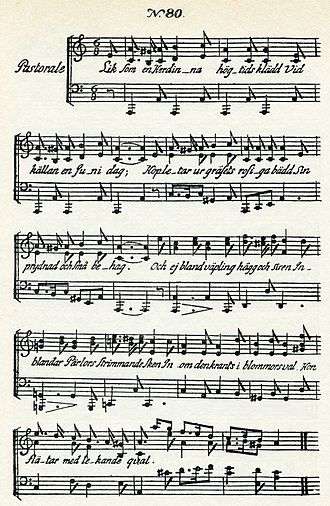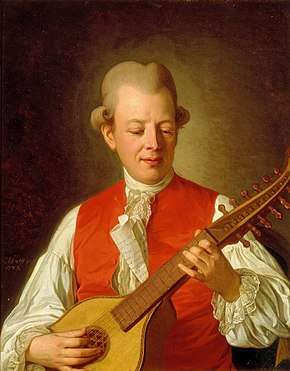Liksom en Herdinna, högtids klädd
Liksom en Herdinna, högtids klädd (Like a Shepherdess, dressed for a solemn feast), is one of the Swedish poet and performer Carl Michael Bellman's best-known and best-loved songs, from his 1790 collection, Fredman's Epistles, where it is No. 80.

The epistle is subtitled "Angående Ulla Winblads Lustresa til Första Torpet, utom Kattrumps Tullen" (Concerning Ulla Winblad's pleasure-trip to Första Torpet, outside Kattrump Tollgate).
The Epistle is a pastorale, starting with a near-paraphrase of Nicolas Boileau-Despréaux's French guide to the construction of pastoral verse.
Context
Carl Michael Bellman is the central figure in Swedish song, known for his 1790 Fredman's Epistles and his 1791 Fredman's Songs. He played the cittern, accompanying himself as he performed his songs at the royal court.[1]
Jean Fredman is a fictional character and the supposed narrator in Bellman's epistles and songs, based on a real watchmaker of Bellman's Stockholm.[2] The epistles paint a picture of the demimonde life of the city during the eighteenth century, where strong drink and beautiful "nymphs" like Ulla Winblad create a rococo picture of life, blending classical allusion and pastoral description with harsh reality.[1][2]
Song
Epistle 80 is dedicated to the poet and founder member of the Swedish Academy, Johan Henric Kellgren.
The song has six verses, each of 8 lines. The rhyming pattern is ABAB-CCDD. The music is in 6
8 time and is marked pastorale.[3] The source melody is unknown.[4]
The song starts with a near-paraphrase of Nicolas Boileau-Despréaux's classic 1674 L'Art Poetique, a guide on the construction of pastoral verse:[5]
Telle qu’une bergère, au plus beau jour de fête,
De superbes rubis ne charge point sa tête,
Et, sans mêler à l’or l’éclat des diamants,
Cueille en un champ voisin ses plus beaux ornements;[6]
The first verse of the epistle runs:[7]
| Swedish original | Prose translation |
|---|---|
| Liksom en Herdinna, högtids klädd, Vid Källan en Juni dag, Hopletar ur gräsets rosiga bädd Sin prydnad och små behag. Och ej bland Väpling, Hägg och Siren, Inblandar Pärlors strimmande sken, Innom den krants i blommors val, Hon flätar med lekande qval. | As a Shepherdess splendidly dressed By the spring one day in June gathers from the grass's rosy bed adornments and accents for her dress and not among clover, wild cherry and lilac does she mix the shimmer of pearls within her chosen wild flower wreath that she's twining with playful care. |
Reception

Bellman's biographer, Paul Britten Austin, describes the song "with its almost religious invocation of a shepherdess, 'clad for some solemn feast'" as "more lovely in Swedish" than in Boileau's French. He comments that in the Epistle, Bellman depicts the countryside just north of Stockholm like a Constable painting, with "Mark how between meadows all awry/the Cot to the lake descends... Where farmer heavy on staggering wheel/Makes haste to his hearth and evening meal". However he finds "quintessentially Swedish" the mood of high summer, with a swallow flying into the room, the cock crowing outside, and the bell of the village church ringing steadily. Everything is perfectly innocent until the last verse, when "Ulla, flat in the face of all Boileau-esque canons of what is permitted in a pastoral and forgetting all new-found respectability, falls into bed with her cavalier, both having drunk too much."[5]
The Epistle has been translated into English by Eva Toller.[8] It appears on the 1969 studio album Fred sjunger Bellman by Fred Åkerström, re-released on CD in 1990,[9] and on Mikael Samuelsson's 1990 Sjunger Fredmans Epistlar.[10]
References
- "Carl Michael Bellmans liv och verk. En minibiografi (The Life and Works of Carl Michael Bellman. A Short Biography)" (in Swedish). The Bellman Society. Retrieved 25 April 2015.
- Britten Austin, 1967. Pages 61–93.
- Hassler and Dahl, 1989, pages 182–185
- Massengale, page 204
- Britten Austin, 1967. Pages 153–155.
- Boileau-Despréaux, Nicolas (1837). Œuvres complètes, avec des notes par m. Berriat-Saint-Prix. p. 191.
- Bellman, 1790
- Toller, Eva. "Liksom en herdinna - Epistel Nr 80". Eva Toller. Retrieved 9 March 2016.
- "Fred sjunger Bellman". Svensk mediedatabas. Retrieved 23 March 2014.
- "Mikael Samuelson – Sjunger Fredmans Epistlar". Discogs. Retrieved 12 March 2016.
Sources
- Bellman, Carl Michael (1790). Fredmans epistlar. Stockholm: By Royal Privilege.
- Britten Austin, Paul. The Life and Songs of Carl Michael Bellman: Genius of the Swedish Rococo. Allhem, Malmö American-Scandinavian Foundation, New York, 1967. ISBN 978-3-932759-00-0
- Britten Austin, Paul. Fredman's Epistles and Songs. Stockholm: Proprius, 1990 and 1999.
- Hassler, Göran; Peter Dahl (illus.) (1989). Bellman – en antologi [Bellman – an anthology]. En bok för alla. ISBN 91-7448-742-6. (contains the most popular Epistles and Songs, in Swedish, with sheet music)
- Hassler, Göran; Peter Dahl (illus.) (1989). Bellman II – en antologi [Bellman – an anthology]. En bok för alla. ISBN 91-7448-837-6.CS1 maint: multiple names: authors list (link) (contains the remaining Epistles and Songs, in Swedish, with sheet music)
- Kleveland, Åse; Svenolov Ehrén (illus.) (1984). Fredmans epistlar & sånger [The songs and epistles of Fredman]. Stockholm: Informationsförlaget. ISBN 91-7736-059-1.CS1 maint: multiple names: authors list (link) (with facsimiles of sheet music from first editions in 1790, 1791)
- Massengale, James Rhea (1979). The Musical-Poetic Method of Carl Michael Bellman. Stockholm: Almqvist & Wiksell International. ISBN 91-554-0849-4.
